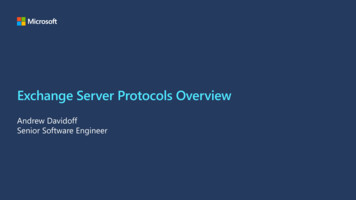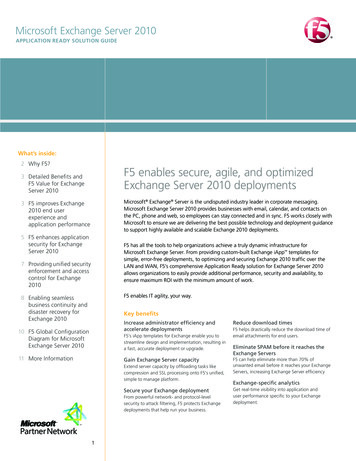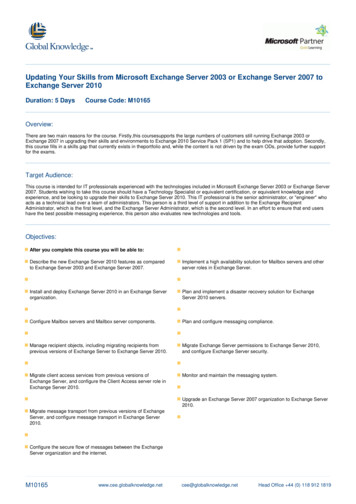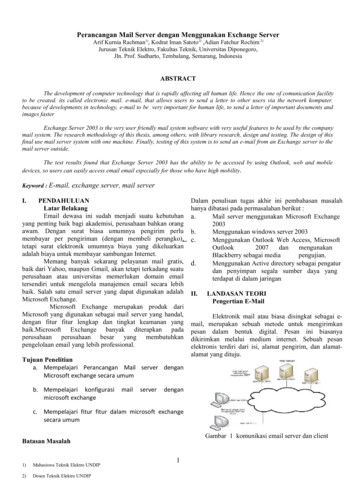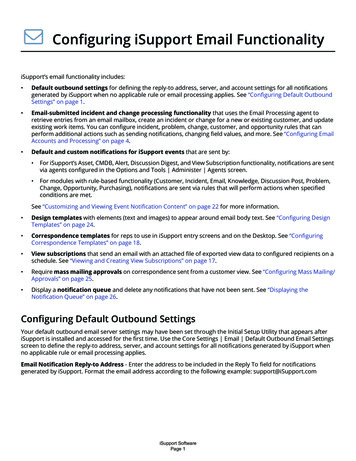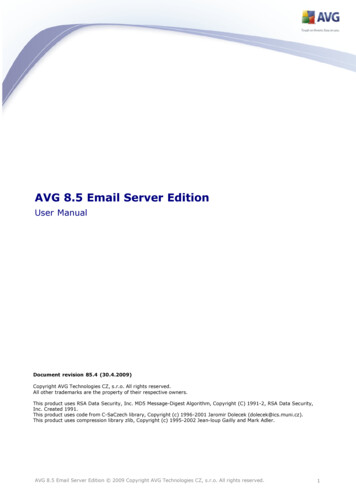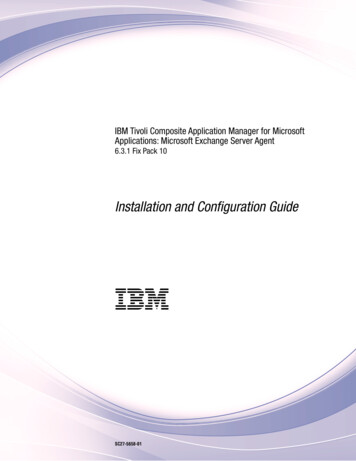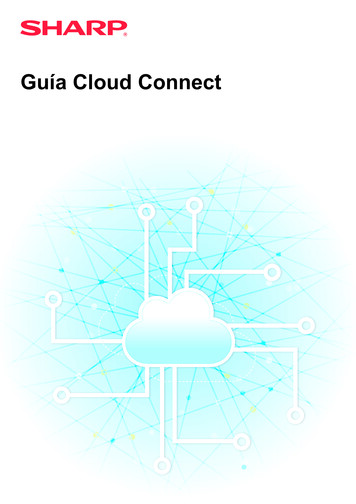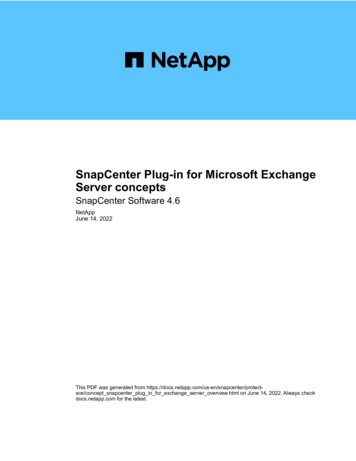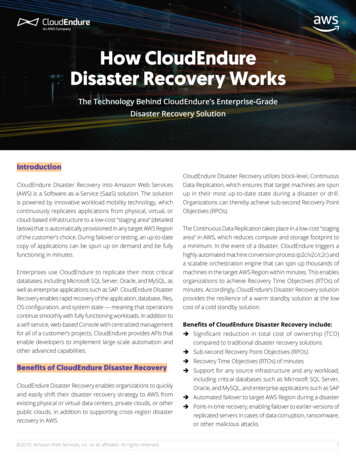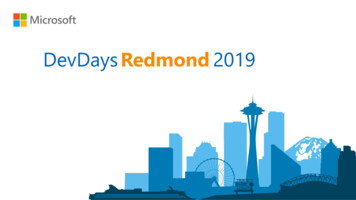
Transcription
Exchange Server 2019 ProtocolsAndrew DavidoffSenior Software Engineer
New in Exchange Server 2019AgendaExchange Protocols scopeExchange Protocols detailsChoice of protocol familyResources
What’s new in Exchange Server 2019? Security Windows Server Core support (less attack surface area) Block external access to Exchange admin center (EAC) and theExchange Management Shell Performance Improved search infrastructureFaster, more reliable failoversMetacache database – performanceModern hardware support: up to 256 GB of memory and 48 CPUcores
What’s new in Exchange Server 2019? Clients Calendar - Do Not ForwardCalendar - Better Out of OfficeCalendar - Remove-CalendarEvents cmdlet (for admins)Assign delegate permission via PowerShellEmail address internationalization (EAI)
Exchange Protocols
Glossary MAPI Mail API, since 1990th. Originally library used by Outlook for Windows Desktop. RPC Remote Procedure Call. On-Prem Exchange Server Physical Exchange Server in your own server topology Exchange Online Exchange Server in the Cloud (Microsoft 365) Hybrid Exchange Configuration where on-prem topology and Exchange Online tenant areconnected
ExchangeOnlineMicrosoft365ServicesRestGraphCloud (M365)Dev AppsEWSExchangeOn PremMAPIMS ClientsEASOn Prem (Exchange Server2019)
Client communication with Exchange e
There is more to Exchange then emailCalendarsRecurring meetings, cross time zone schedulingAvailability – both attendees and conference roomsTasksOne-time or recurringTracking Due Date and AssignmentContactsMultiple Contacts Folders, Suggested ContactsAddress book for mobile devicesRemindersFor Calendars, Tasks, EmailsNotificationsServer notifies Client that mailbox changed (new mail, etc.)Push or Pull
There is even more to Exchange then emailRulesServer Side and Client SideApplied on messages on arrival, even when client is not connectedOut of OfficeInternal and External recipients can get different OOF messagesTime restrictionsMail TipsShow user that recipient is Out of OfficeWarning that mail includes very large DL, etc.ComplianceLegal Search (eDiscovery)Legal HoldArchivingSeparate Archive for old emails, accessible by clientRetention policies set per folderAnd so on.Delegate Access, Load Balancing. Mailbox moves, High Availability, and more.
Protocol Families ROP Protocols Originally RPC transport HTTPS transport introduced inExchange 2013 NSPI is used for Address Book access Exchange Web Services (EWS) ActiveSync (EAS) Other protocol groups Autodiscover Content Conversion Standards Support
Overview Document: MS-OXPROTO Defines protocol families Scenario-Based How protocols work together Walkthroughs and examples Display an e-mailSend an attachmentCreate an appointmentand others
ROP Protocols
History of terminology – what is “ROP”? Initial name: RPC protocols Remote Operations (ROPs) over RPC connection RPC is just a channel to exchange binary blobs between client and server This binary blob can be transmitted by other underlying protocols RPC over TCP or RPC over HTTPS (MS-OXCRPC) Pure HTTPS (MS-MAPIHTTP) MAPIHTTP is RPC replacement (Exchange Server 2013) The same binary blob is now transmitted over HTTP, bypassing RPC Since it’s not RPC any more, we now call them ROP Protocols In many places it is still called “Exchange RPC protocols”, sometimes MAPI
ROP Protocols Transport layers: RPC/TCP, RPC/HTTPS or pure HTTPS Low-level access to Exchange Server Storage Optimized to minimize traffic on the wire Very complex parsing Used by MAPI Workhorse for Outlook for Windows Desktop communication withExchange Server Originally implemented in Exchange 4.0 Extended and re-architected several times
ROP Protocols - Continue ROPs protocols define both Server and Client behaviors Client behaviors are very complex Wrapped in MAPI implementation on Outlook for Windows Desktop Client performs logic to maintain complex items: Messages, Folders,Calendar, Contacts, Tasks, etc MAPI/CDO library is no longer supported Document Naming: [MS-OXO*] and [MS-OXC*] Over 40 Protocols, 3000 pages
Example of complexity in ROP opIDROP DataBinary BlobROP2RopID HSOT TableROP DataNote: No ROP Data size or end marker.Every ROP Data in the blob must be parsed.Every RopID has different ROP Data structure.Number of documented RopIDs: 130
Where to start: ROP Protocols
ROP Protocols Summary Not recommended for new applications due to complexity Modern Exchange Server has good alternatives Exchange Web Services for On-Prem Server Microsoft Graph for Exchange Online
Exchange Web Services (EWS)
EWS Protocols Alternative to ROP protocols Higher level of abstraction compared with ROP protocols EWS implements messages, attachments, calendar events, contactson server side Outlook for Windows Desktop uses subset of EWS protocols Unified Messaging, MailTips, Availability, OOF, Office Apps, Room List,Archive, Mailbox Policies, Calendar Sharing, Site Mailboxes, etc. Intuitive/readable XML (easier troubleshooting)
EWS Protocols- continued Versioning Clearly defined RequestServerVersion header element in each request let’s client to requestversion-specific behavior Transport: SOAP over HTTP(S) Code in any language/platform that supports HTTP/SOAP calls SDKs are available as well Document Naming: [MS-OXW*] 43 Protocols, 2000 pages First implementation: Exchange Server 2007
Where to start: EWS Not hierarchical Start withMS-OXWSCORE
EWS SDKs Exchange Web Services (EWS) Managed API WebServices/ https://github.com/OfficeDev/ews-managed-api ged-apiews-and-web-services-in-exchange
EWS Summary Recommended protocol for on-prem Exchange Serverapplications Basic authentication only No OAUTH GRAPH/REST APIs is better alternative for Exchange Onlineand Hybrid Exchange Server Modern authentication Seamless integration with other services (SharePoint, OneDrive, AzureActive Directory, etc.) Future updates will happen in Microsoft Graph APIs
Exchange Active Sync (EAS)
EAS Protocols Lightweight synchronization protocol for Exchange Server Optimized to work on high-latency and low-bandwidth networks Designed to minimize device power usage High level of abstraction, similar to EWS in complexity Provides access to email, calendar, contacts, tasks, documents, etc. Transport Layer: WBXML over HTTPS Industry standard Several non-Exchange Server implementations Wide range of clients –iOS, Android, Windows, etc
EAS Protocols Details Versioning Clearly defined version negotiation Version-specific features documented in open specifications Document Naming: [MS-AS*] 15 Protocols; 900 pages First Implementation: Exchange Server 2003
SCALMS-ASDOCMS-ASCNTCMS-ASPROVWhere to start: EAS
Typical Usage of Exchange ActiveSync Mobile Applications Tablets and lightweight desktop applications Allows for low-bandwidth and high-latency data (Internet)connections while scaling reasonably on high-speed connections. Additional considerations Not feature parity with Exchange ROPs and Web Service (EWS)protocols Licensing requirements Microsoft Graph APIs is better alternative for Exchange online
Other Exchange protocols Autodiscover Content Conversion Standards-based protocols – Compliance and Extensions [MS-OXPROTO] is a good reference
What Protocols to use?
On-Premises choice EWS is recommended for new applications ROPs protocols are very complex EAS has special purpose Note that Outlook for Mac uses EWS Hybrid mode brings on-line richness to on-premimplementations
Exchange Online has more If you develop for Exchange Online, consider Microsoft GraphAPIs https://developer.microsoft.com/en-us/graph/ https://aka.ms/30DaysMSGraph
Resources
Exchange Protocol Test Tools Protocol Test Suites Protocol families: EAS, EWS, and ROPs (RPC/MAPIHTTP) Fiddler Inspectors: Protocol families: ROPs (MAPIHTTP) Additional associated protocols
Exchange Protocol Resources All Exchange protocol documents e server protocols Fiddler inspectors for Office and Exchange protocols -Fiddler Protocol Test Suites https://github.com/OfficeDev/Interop-TestSuites Help with Open Specifications: mailto:dochelp@microsoft.com Office Interoperability blog: offintbloglp/61fc0f77-b3e6-4b4f-aea9-ce472fa98835
Questions?
Thank you.
Delegate Access, Load Balancing. Mailbox moves, High Availability, and more. . (Exchange Server 2013) The same binary blob is now transmitted over HTTP, bypassing RPC Since it's not RPC any more, we now call them ROP Protocols In many places it is still called "Exchange RPC protocols", sometimes MAPI .

